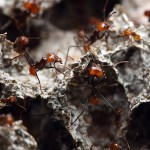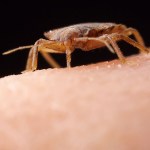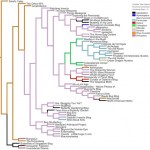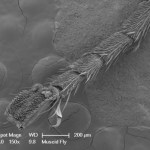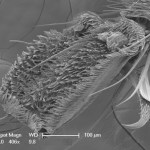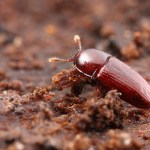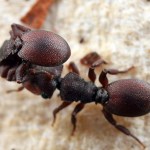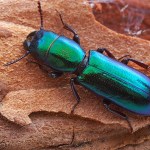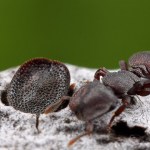
I apologize for the slow blogging this weekend. We took a little road trip up to beautiful Madison, Wisconsin and were too busy with bratwurst, cheese, beer, and roller derby to bother with the internet.
Atta cephalotes in the fungus garden
The University of Wisconsin is home to Cameron Currie, whose lab is at the cutting edge of insect-fungus-microbe evolutionary biology. Cameron is one of the people who first realized that the classic ant/fungus mutualism was more complex than just the insect and the fungus, involving all sorts of microbes, including some that live on the ants' exoskeleton…
This week we delve into the genes of the mystery organism. Here's a short snippet of DNA:
ATGTCGCGTATCATGGAAAAGGAAAACATCACCGAAAATCTGGAAAAGATTTCCATCAAGAATGCTCGTA
5 points for the first person to pick the genus and species, and 5 points to the first person who can explain why this particular gene was targeted for study.
I'll post the answer tomorrow. Since we've reached the end of the month, I'll tally all the points from the preceding mysteries and announce the March/April mystery winner, who is entitled to either 1) any 8 x 10 print from my photo galleries, or 2) a guest blog slot on any (…
You're in luck! Antweb has added an excellent blog to handle submitted questions. The answer squad is headed by myrmecologists at the Chicago Field Museum, and so far they've fielded queries about what ants do in winter, whether fire ants will reach the northern U.S., the difference between ants and termites, and several others.
Send your questions to askantweb@calacademy.org.
From "Life in the Undergrowth", perhaps the finest insect documentary ever made, a scene featuring Australia's intertidal ants:
A few years back I traveled through northern Queensland with myrmecologists Phil Ward and Gary Alpert. Having heard about the aquatic abilities of these ants, we searched for them in a mangrove forest just outside the Cairns airport while waiting for our flight. After a bit of looking, Phil found a foraging trail of large black ants going up a mangrove trunk.
We dropped a few into the water below, and sure enough- swimming ants! It's a remarkable behavior.
This velvety worm-like creature may not look like a beetle, but it is. Beetles are like butterflies, passing through a complex metamorphosis on the way to adulthood, and this insect is the larval stage of a soldier beetle.
photo details:
Canon EOS 50D camera
Canon MP-E 65mm 1-5x macro lens
ISO 100, f/13, 1/250sec
Earlier, while noting greater rates of pseudonymous blogging by women, Morgan Jackson raised the topic of why the majority of tenure-track science positions go to men. It's a striking pattern, especially considering that at the graduate student level women predominate in many fields- including entomology.
The obvious culprit is that women face discrimination in hiring decisions, as several of our commentators mention. And make no mistake- that does happen.
But I've seen enough people drop out of science to realize that there's more than just individual gender-based discrimination at work.…
...just for you.
Cimex lectularius, the common Bed Bug
More photos from this series are posted here.
photo details:
Canon EOS 50D camera
Canon MP-E 65mm 1-5x macro lens
ISO 100, f/13, 1/250sec
What happens if you score bug blogs for various characters and crunch them through a phylogenetic analysis?
Morgan Jackson investigates:
Although Morgan's exercise was tongue-in-cheek, he did uncover a pattern worthy of further exploration:
The last thing I want to comment on is the huge skew between male and female insect bloggers. Of the 58 blogs where I could determine the author's sex, only 28% of them were written solely by women. Even more concerning perhaps is that 38% of these women bloggers choose to remain anonymous, while not a single male blogger chose to stay private! With…
What was that odd squishy-hairy thing in yesterday's SEM?
It's the tip of the foot of a muscid fly, showing the adhesive pads (called pulvilli) that allow the fly to cling to surfaces. Here's a slightly less magnified view:
Points are awarded as follows:
-Two for JasonC., for being the first to pick that it was a foot of some sort.
-Five for Jim Harrison, who bagged the organism.
-Two to Gunnar for guessing the empodium, which is one of the structures visible in the image.
-Two to Roberto Keller, for providing more precise technical detail than that given preceding guesses.
update Boy, am I…
Forget the heavy pro-grade camera gear for a moment. This shot was taken with a $300 Panasonic Lumix DMC-ZS3 digicam. These small cameras do wide-angle macro exceptionally well, and their tiny sensors and lenses give them a small-world perspective that SLR cameras struggle to replicate. Here, I placed the camera on the ground underneath a foot-high canopy of mayapples.
Tonight's mystery* takes us down into the magical world of scanning electron microscopy.
Five points for picking the organism and five for picking the structure. As usual, only the first correct answer in each category collects the points.
The cumulative points winner for the month of April gets to choose either 1) any 8x10 print from my photo galleries, or 2) a slot as a Myrmecos guest blogger on a safe-for-work topic of their choosing.
*Image by the lovely Jo-anne Holley
Today, it's the New York Times. Consider this Q & A:
Q. Can the tiny ants that visit me every spring hop like a flea? Sometimes I look down and suddenly there one is, working its way across my anatomy.
A. It is possible. Several of the estimated 10,000 to 14,000 identified species of ant are capable of hopping or leaping, including at least one with a potentially fatal bite...
The jack jumper ant, Myrmecia pilosula, which is native to Australia, jumps when agitated. Its highly toxic venom allows it to prey upon insects as large as wasps.
Jerdon's jumping ant, an Indian species that has…
Strumigenys rogeri in the leaf litter
In 1982, a small journal called The Coleopterists Bulletin carried a two page note by beetle expert Terry Erwin that increased- by an order of magnitude- the estimated number of species on the planet. Erwin crunched some back-of-the-napkin numbers based on the tree specificity of arthropods he'd collected in Panamanian tree canopies and the richness of tropical tree species worldwide to surmise that the earth should hold 30 million species. An impressive bump from the 1 to 2 million that was the going estimate.
Later research on canopy arthropods (For…
If ants were to drop acid I'm not sure what they'd experience. But this entrancing short film by Jörg Brönnimann is as good a guess as any:
ant-views from Jörg Brönnimann on Vimeo.
Polistes dominula, the European Paper Wasp
captured with an iPhone
As an insect guy, the first question I ask about any camera is: Can I shoot bugs with it?
To my great disappointment, the answer for most cell phones is no. Cell phone cameras are normally fixed to focus at distances useful for party pictures and street shots. Fixed-focus simplifies the mechanics of the onboard camera, but it also makes close-ups of small subjects impossible. Even Apple's iPhone 3GS- which has variable focus- doesn't focus quite closely enough do anything but the largest insects. So when an aphid plague…
Philothermus glabriculus (Cerylonidae)
Urbana, Illinois
A while back I noted that, at a rate of one beetle per week, I'd need about 10,000 years to get through all the described species. Since I made that comment we're getting closer to needing only 9,999 years, but if the Coleopterists keep discovering new ones I'm not sure what I'll do*. There are an awful lot of beetles.
In any case, this little Cerylonid is common under the bark of dead trees across eastern North America. Its diminutive size (only a couple millimeters long) makes it rather difficult to spot, so to find Philothermus you'…
The downside to a celebrated and prolific scientific career is that you generate enough of a paper trail for something you concluded, somewhere, to be erroneous.
I happened on an amusing example this week while photographing the Caribbean turtle ants I blogged about earlier. Like most of the world's 12,000 or so ant species, not much is known about the biology of Cephalotes varians. However, famed myrmecologist E. O. Wilson maintained a few lab colonies in the 1970's and detailed his hours of meticulous observations in a paper entitled "A Social Ethogram of the Neotropical Arboreal Ant…
I would be remiss in my duties as an ant blogger to not pass this on from NCBI ROFL:
Transcultural sexology: formicophilia*, a newly named paraphilia in a young Buddhist male.
*The sexual interest in being crawled upon or nibbled by small insects, such as ants
Abstract: Children whose species-specific, juvenile sexual rehearsal play is thwarted or traumatized are at risk for developing a compensatory paraphilia. The case of a Buddhist male exemplifies the cross-cultural application of this principle. His syndrome, formicophilia, was endogenously generated without reference to or influence by…
...for no reason other than that I need something sparkly this morning.
Temnoscheila sp. bark-gnawing beetle, Trogossitidae
Tucson, Arizona
The reflective integument makes this beetle a real trick to shoot. It's like trying to photograph a mirror- a regular flash either reflects back at full, blown-out glare or not at all. So I shot this beetle in a white box, where the soft, even lighting can bathe the insect without sharp hightlights or deep shadows.
photo details:
Canon EOS 20D camera
Canon MP-E 65mm 1-5x macro lens
ISO 100, f/14, 1/250sec
What was that inexplicable bit of chitin hiding away in a hole in a twig?
This photo should help:
It's the heavily sclerotized head shield of a Cephalotes varians turtle ant. Ants in this mostly Neotropical genus inhabit pre-existing cavities in trees and branches, a limiting resource that spurs intense competition among colonies of various tree-dwelling species. Workers come in two size classes: small and relatively lithe, and tank-like with a dinner plate for a head.
Turtle ants aren't fighters. Rather, they're all about defense. If a colony gets hold of an old beetle burrow, the heavily…
